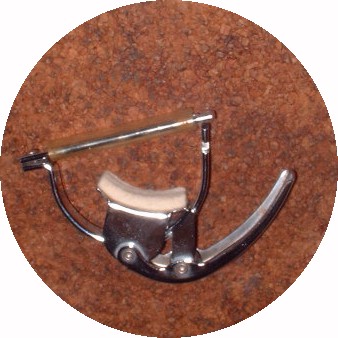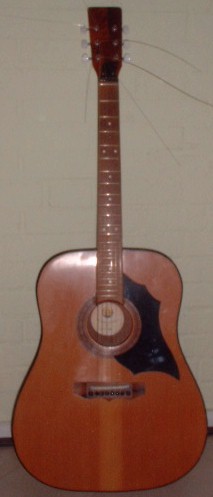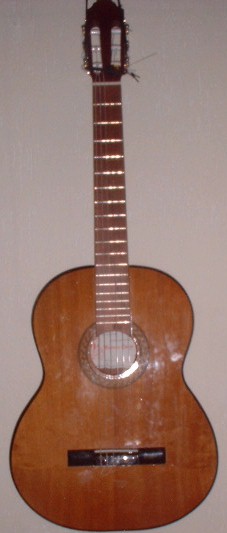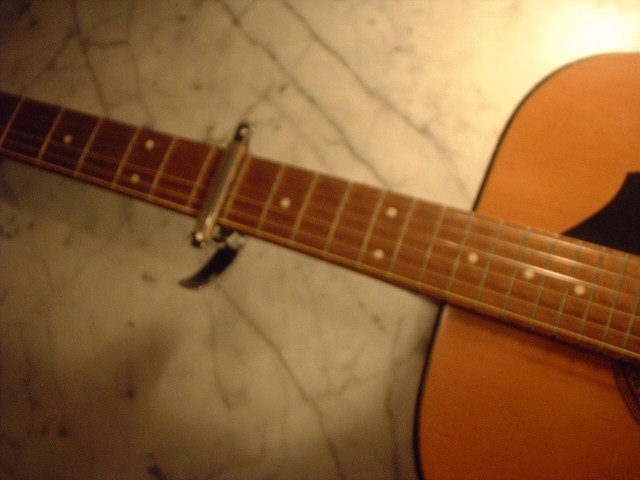Some Portuguese guitar links (click on one of the underscores):
Casa do fado e da guitarra portuguesa
How to fake a normal guitar into a Portuguese guitar
(Is "fake into" valid English? I see nobody else use the word like this in Google!)
A portuguese guitar is a beautiful and delicate instrument, so it cannot be cheap. Even the relatively cheap ones, like the one you can buy here (look for "instrumentos de corda portugueses" in the catalogue) or here online, cost quite a bit of money, and more so when considering shipping costs.
To get an idea about how the tuning of the string works out, it is
possible to string and tune a normal guitar in such a way that, with
the help of a
 capodastro,
it will have the pitch of a Portuguese
guitar. It still doesn’t sound like the real thing, and it probably
also doesn’t feel like it (I never touched a real one myself yet),
but it is useful to see how the notes, of what you hear others play or
would like to play yourself, are positioned on the keyboard.
capodastro,
it will have the pitch of a Portuguese
guitar. It still doesn’t sound like the real thing, and it probably
also doesn’t feel like it (I never touched a real one myself yet),
but it is useful to see how the notes, of what you hear others play or
would like to play yourself, are positioned on the keyboard.
It’s best to use a
 western-style guitar,
rather than a
western-style guitar,
rather than a
 Spanish guitar,
for two reasons:
Spanish guitar,
for two reasons:
They are designed for steel strings. The Portuguese guitar also has steel strings. This also affects vibrato: strings whose ratio between the tensioned string and the relaxed string is smaller, are more sensitive to changes in that ratio, and so for longitudinal (in the direction of the string) and lateral (perpendicular to the string) vibrato.
That is why steel strings allow for easier vibrato than do nylon strings, and thinner, low tension strings do too, in comparison with thicker, high tension strings. It may also be the reason why Jimi Hendrix often tuned his electric guitar one semitone lower than normal (E flat).Spanish guitars have a smaller part of the fretboard sticking out of the guitar case. The case usually begins at the 12th fret, whereas on a western style guitar, a.k.a. folk guitar, this is the
 14th,
or 15th fret.
Because we are going to use a
14th,
or 15th fret.
Because we are going to use a
 capodastro
for retuning to an imitation Portuguese guitar, we will need that room.
capodastro
for retuning to an imitation Portuguese guitar, we will need that room.
A Portuguese guitar is smaller than a normal guitar, also in terms of
effective string length. The ratio is about 2 to 3. That means with the
same strings, a Portuguese guitar would sound about a fifth higher
than a guitar. The same effect can be achieved by placing a capodastro
(or capotasto, but today is the first time I see that word;
but read this explanation) behind
(i.e. to the left of) the seventh fret. To get more room, we could
also put on the fifth fret, but that cause lower notes, the string
must be tensioned more, and that makes vibrato more difficult.
Using the seventh fret has the added advantage that the fifth fret
can be used to switch quickly and easily from the Lisboa-tuning
of the Portuguese guitar to the Coimbra tuning, which is one second
(two semi-tones) lower.
The tuning of the Portuguese guitar is as follows (from high pitch to low pitch; a′′ means 880 Hz, a′ means 440 Hz, a=220, A=110 etc.):
| Coimbra | Lisboa | ||
|---|---|---|---|
| Germanic languages |
Romance languages |
Germanic languages |
Romance languages |
| a′ a′ | la | b′ b′ | si |
| g′ g′ | sol | a′ a′ | la |
| d′ d′ | re | e′ e′ | mi |
| a a′ | la | b b′ | si |
| g g′ | sol | a a′ | la |
| c c′ | do | d d′ | re |
When starting from a six-string guitar, we ignore the double strings,
and use 2 e′ strings, 1 b strings, 2 g strings
(or a g and d instead),
and 1 A string. If you have a choice of different sizes (thickness,
gauge), prefer thin ones, e.g. (in decimal inches) e′ .010, b′ .014,
g .023 and A .038.
Tune them as indicated in the following table, which assumes the capodastro
in position VII (seventh fret) to get a Lisboa tuning.
The "tune to" column is without the capodastro, the "resulting pitch"
column is with the capo in place. Again, the table runs from high pitch
(strings farthest away from your eyes and nose when playing) to low
pitch (closest).
| Guitar string - | - Tune to - | - Resulting pitch |
|---|---|---|
| e′ | e′ | b′ |
| e′ | d′ | a′ |
| b | a | e′ |
| g | e | b |
| d | d | a |
| A | G | d |
Tuned this way, the capo will produce Coimbra tuning when on the fifth fret. If you prefer Lisboa at V and Coimbra at III, you can use this data (assuming capo in V; note that one g string has now changed to a d string):
| Guitar string - | - Tune to - | - Resulting pitch |
|---|---|---|
| e′ | f#′ | b′ |
| e′ | e′ | a′ |
| b | b | e′ |
| g | f# | b |
| g | e | a |
| A | A | d |
If however you have a 12-string guitar you can (mis)use for this
purpose, that gives you the opportunity to comes even closer to
the tuning of the Portuguese guitar, because it too has twelve
string. Both type of guitar have the higher strings tuned in
unison, but the lower three pairs in octaves, to get a richer
sound.
You could then tune as follows:
| Guitar string - | - Tune to - | - Resulting pitch |
|---|---|---|
| e′ e′ | e′ e′ | b′ b′ |
| e′ e′ | d′ d′ | a′ a′ |
| b b | a a | e′ e′ |
| g e′ | e e′ | b b′ |
| d e′ | d d′ | a a′ |
| A g | G g | d d′ |
Some Portuguese guitar links (click on one of the underscores):
Casa do Fado e da Guitarra Portuguesa
Explanation capotasto/capodastro
My Italian friend Francesco Marcheselli sent me this explanation:
A "capotasto", in the guitar vocabulary is basically a short bar that can
be fastened across the fingerboard to transpose the key of the instrument.
Classical guitarists never use it, but folk and popular players couldn’t do
without. Flamenco players use it, too, and call it "cejuela".
It is available in a wide array of technical variants, but one of the most
successful ones was (and still is) the "spring-and-lever" kind originally
made by the Capo d’Astro string making company. The sound being very
similar, the two names have become confused.
The term "capotasto" is italian, just as so many other musical terms: now a
"tasto" (latin "tactus") means "something you operate with your fingertip".
The term is most appropriate when you think of a piano keyboard
("tastiera"), but is also used, as a translate, for stringed instruments
when their fingerboard is armed with transversal bars (as in the guitar, as
opposed to the violin): the space where the finger operates, between any
two bars, is a "tasto". The very first bar, where the strings start ("upper
bridge" or "nut") is the "capotasto" (= "head fret"). Since the effect of
the tool is exactly that of promoting any fret to the role of "first" fret,
the name is justified.
Copyright © 2002 R. Harmsen. All rights reserved.